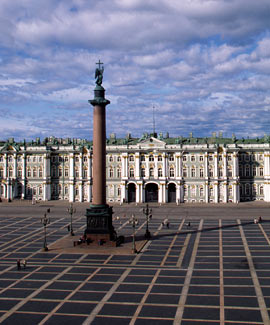 |
 |
 |
 |
 |
|
| Visit the Web site |
| The State Hermitage Museum, St. Petersburg | ||
The Hermitage is a world-famous museum of art and cultural history. Within in its walls are close to three million objects. Among them are quite a few true masterpieces of art and unique artifacts from many countries and peoples of the world, ranging from deepest antiquity to the present day. The Hermitage is also a unique architectural complex, an outstanding monument of Russian architecture of the eighteenth and nineteenth centuries, and an inextricable part of St. Petersburg's historical center. And finally, the Hermitage is a major scholarly and cultural educational center of modern Russia. The museum's activity is in direct contradiction to the literal meaning of its name. "Hermitage" comes from the French ermite, which means "empty lot," "hidden corner," or "hermit's refuge." This was the name given in eighteenth-century France to small pavilions on palace grounds. They were intended for rest and seclusion within the intimate circle of titled personages. Originally, the apartments of the Winter Palace, the main residence of the Russian sovereigns, was called the Hermitage, where Empress Catherine II the Great held her famous assemblies for a narrow circle of close friends. The walls of those apartments were hung with paintings that were the nucleus of the gallery later called the Hermitage. It is customary to consider 1764 as the year the Hermitage was established, when a collection of 225 paintings (primarily Dutch and Flemish artists)—purchased in Berlin on Catherine's orders from the merchant Gotzkovsky—arrived at the Winter Palace. Wanting to be known as an enlightened despot and generous patron, Catherine II did not skimp on purchases of art abroad, acquiring entire collections. The most important for the creation of the Hermitage picture gallery were purchases made in Dresden in 1769 (the collection of the Saxon minister, Count Heinrich von Bruel), in Paris in 1772 (the rich collection of Pierre Crozat and his nephew, Louis-Antoine Crozat, Baron de Thiers), and in London in 1779 (the gallery of British Prime Minister Sir Robert Walpole). Along with paintings, the Hermitage received collections of engravings and drawings, antique artifacts, Western European sculptures, works of applied art, arms, coins, medals, and books (including Voltaire's library). The French philosopher Denis Diderot, the German enlightener Melchior Grimm, and the Russian diplomats D. A. Golitsyn and A. I. Musin-Pushkin made purchases for the Hermitage. In the nineteenth century, artifacts from archeological excavations were sent to the Hermitage. In the mid-nineteenth century, on a decree of Emperor Nicholas I, a special building was constructed to house the collection, the New Hermitage, which in 1852 became the first art museum in Russia. After the Revolution of October 1917, the Hermitage collections were significantly enlarged through the nationalization of private collections (of the Stroganovs, Yussupovs, and Shuvalovs) as well as with the collections of suburban palaces and several other museums of Petrograd (in particular, the museum of the Academy of Arts and Baron Stieglitz's Museum of Applied Arts). Before World War II, the entire premises of the Winter Palace were given to the museum. But the Hermitage collections were diminished when a number of masterpieces were sold abroad in the 1920s and 1930s. At present the seven scholarly departments of the Hermitage—Archeology of Eastern Europe and Siberia, History of the Ancient World, Culture of the Peoples of the East, History of Russian Culture, Western European Art, Numismatics, and the Armory—are meticulously studying and cataloguing the various collections that form the museum's holdings. This itemizing, on the one hand, helps clarify the issue of additions to the museum, perfecting and renewing its expositions, and on the other, forms the foundation of the Hermitage's wide-ranging exhibition activity. The museum's scholarly and educational division has developed a multifaceted excursion and lecture series. The restoration departments conserve and restore works of art and artifacts of material culture. The museum's exhibits (there are more than 350 exhibition rooms) are at present located in five buildings, connected by passages: the Winter Palace, the three Hermitages (Small, Old, and New), and the Hermitage Theater, in the foyer of which there are now regular exhibitions. In the 1980s, the palace of St. Petersburg's first governor, A. D. Menshikov, which holds an exhibit on the history of Russian culture of the first third of the eighteenth century, and part of the General Staff of the Russian Army building, which houses the works of Maurice Denis and Pierre Bonnard, and an exhibition of Empire-era applied arts, were added to the Hermitage museum complex. In 1990, after the restoration of the Hermitage was completed, fragments of the Winter Palace of Peter I the Great, discovered during excavation, were opened to the public. |